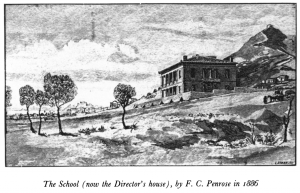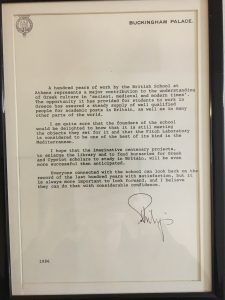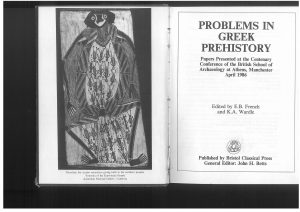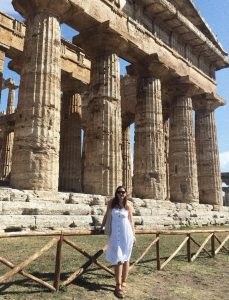Back to 1986: British School at Athens Centenary
Orsolaina Felago (Università degli Studi della Campania) completed an Erasmus+ traineeship at the BSA, January–March 2021. Because of the national lockdown, original plans changed and Orsolaina worked remotely, helping to compile a database of all events (lectures, conferences etc.) that have taken place at the BSA since 1886. During this task, she became interested in the BSA’s Centenary celebrations.
Today we take you back in time to a celebration of the first 100 years of work conducted by the British School at Athens. It was 1986 when the BSA celebrated completing the first century of work. This represents not only an historical anniversary of the birth of one of the most important research institutes, but also 100 years of research and projects. Founded in 1886, the British School at Athens provides a base in Greece for British research on the Hellenic world across all arts, humanities and social science disciplines from the Palaeolithic to the present.

We can find information on the centenary celebrations of the BSA in the Annual Reports of the British School at Athens, published continuously since 1886 that has reported on the range of research conducted by the institution. From the 1984-1985 Annual Report in particular we read about the Centenary launch event: “The Annual Meeting of Subscribers was held in the Rooms of the Royal Geographical Society, Kensington Gore, on Tuesday 5th February 1985. Lectures were given by Lady Helen Waterhouse on ‘The British School Centenary: Some aspects of the last 100 years’.
During the launch event held in 1985 […] “The Chairman read the following Centenary message from HRH The Prince Phillip, Duke of Edinburgh, KG, KT, GBE, Patron of the School: “A hundred years of work by the British School at Athens represents a major contribution to the understanding of Greek culture in ancient, medieval and modern times”.

In addition to giving this lecture, Helen Waterhouse also published: “The British School at Athens: The First Hundred Years”. ‘A good institution has a life of its own, beyond its individual parts; the School in Athens has been called ‘The best academic club in Europe’[…] Published to celebrate the BSA’s centenary in 1986, this book reflects on its influence in the development of Greek archaeology and Hellenic studies. The chapters look at the BSA in London, Athens and Knossos, before providing a detailed overview of the School’s various excavation campaigns and life at the School more generally.
But the main celebration of the centenary took place the next year. Indeed, we know more about the Centenary Celebrations held in Greece thanks to the 1985-86 Annual Report. For the occasion all the living former Directors of the School were able to attend the Centenary Celebrations: J.M. Cook, Mr M. S. F. Hood, Mr A. H. S. Megaw and Mr P. M. Fraser. Present, too, were all living former Chairmen of the Managing Committee, Professors C. M. Robertson, N. G. L. Hammond and P. M. Warren, who all lectured in the Academic Programme, and Dr R. A. Higgins. Among the Universities and Learned Bodies that responded to the School’s invitation to be represented at the Centenary Commemoration were the Universities of Aberdeen, Birmingham, Cambridge, Durham, Glasgow, Leeds, Liverpool, London (University College, King’s College and Institute of Classical Studies), Newcastle upon Tyne, University College of North Wales, Bangor, Oxford and Sheffield. Most generous support and help was given to the School on all sides during the celebration of the Centenary.
“The Archaeological Society of Athens generously placed two rooms in its Hostel during the commemoration and the Academic Programme, for the use of visiting speakers. On the British side, we enjoyed endless help and support from HBM Ambassador, HE Mr Jeremy Thomas and his staff in the British Embassy. The Rt Hon Lord Hailsham of St Marylebone, the Lord Chancellor of England, represented the British Government at the Commemoration. Help from the sister-schools included the loan of accommodation by the American School and the French School; facilities in the American School garden were given for the June 20th Reception. Commemoration was held on Friday, June 20th at 7 p.m. in the Ethniki Pinakotheki in the presence of an invited audience of not less than 500 people, Greek, British and Foreign. After a short introduction by the Director, addresses were delivered by the Minister of Culture, Mrs Melina Mercouri, and the Lord Chancellor, Lord Hailsham. Professor John Boardman, Trustee, then gave a lecture on ‘Greece, Britain and Archaeology’.
The Meeting was immediately followed by a reception in the School gardens attended by some 600 people. The reception was organised by Mrs E. A. Catting, with very welcome assistance from Mr Stephen Townsend and Mr Christos Hadjigeorgiou, Butler to HBM Ambassador.
Furthermore, another landmark event was organised to commemorate the centenary of the British School at Athens. In 1986 a conference was organized by Elizabeth French, later in the 1988 published as ‘Problems in Greek prehistory: Papers Presented at the Centenary Conference of the British School of Archaeology at Athens’. This event took place at the Ashburne Hall in Manchester, bringing together 120 Scholars from a dozen countries. The publication provides a deep immersion into the main topic of the commemoration. A celebration dedicated to the Aegean Neolithic and Bronze Age organized and hosted by Elizabeth French, daughter of Alan Wace, pioneer of Greek prehistory, and herself director-designate of the School.

Here a small extract from the Preface:
“Since its foundation, Students of the British School at Athens have maintained a keen interest in Greek Prehistory. In its Centenary Year it seemed especially appropriate to the Managing Committee to mark this work with a Conference which would not just review the discoveries of the first Century but would look forward to the problems that would particularly deserve attention in the second. The results have been enriched by fruitful discussions with colleagues from many countries. The work was compressed into a mere five days and its members limited in number. By the end of the week it was clear that the Conference had succeeded in its aim. Small groups continued to dispute the day’s papers in every corner of the Hall long after the formal sessions were over”.
In order to use this conference as part of the centenary celebrations, it was important to publish the proceedings of the events as quickly as possible. This rapid publication of the proceedings unfortunately, however, despite the imposing weight and thickness of the volume drew some criticisms for the volume, particularly in a review written by Jack Davis. About the conference, in J. Davis, 1989, “Review of French and Wardle” Antiquity 63, pp. 642-644, he writes:
“Papers are loosely grouped by chronological phase (Neolithic, Early and Middle Bronze Ages, Late bronze Age), or chucked into grab-bags such as “The Mediterranean Orbit”, “Poster Session”, “Exhibitions”, or “Method and Theory”. The texts are extremely uneven in quality and length, ranging from short abstracts, several not worth publishing in any form, to rambling monstrosities. Formatting is erratic, figures and tables are sometimes unnumbered, the volume lacks a list of illustrations, and a mismatched typeface for references give the entire book a decidedly unfinished appearance. The enormous consolidated bibliography is valuable, and a reader will acquire a reasonably good idea of the sort of problems that concern a majority of Minoan and Mycenaean specialists. Many papers, fixated, as they are, on the description of excavation sequences or on the elucidation of fine points of chronology, culture history, or history of art and architecture, will be rough going for non-specialists. Several are especially bright and well argued. Leonard rightly warns of the circular reasoning involved in using Syro-Palestinian stratigraphy as support foe Aegean ceramic typologies. Cavanagh and Laxton establish corbelling as the principle explaining stability of the Mycenaean beehive tombs. Analyses of frescos from Mycenae (marinatos) and Knossos (Niemeier) are models of clarity and precision, as is a proposed typology of bronze stands, of the type found in Greece, Italy and Cyprus in 1st and 2nd millennium contexts”[…]
This critical aspect shows us the importance to publish the papers on occasion of the Centenary, at any cost. As a consequence many factors affected the work. In the publications indeed the authors themselves complain and they write:
“As editors we have been disappointed that so many of our colleagues did not heed their instructions about preparation of texts and illustrations. The extra work this entailed has inevitably delayed the appearance and increased the cost of the volume. In a few cases returned proofs have not reached us so that errors could be corrected and omissions inserted. E.B. French compiled the consolidated bibliography which was printed direct from microcomputer to avoid typographical errors introduced by photo-mechanical reading. Editorial corrections, format and styling have all meant long hours at the keyboard persuading the University of Birmingham mainframe computer and typesetter to cooperate even when they seemed more inclined to produce Linear B than plain English”.
The preface in the beginning of the publication shows us that the authors well knew the challenges of compiling the work itself.
We have virtually walked through the first 100 years of the British School at Athens until now, looking forward to reaching new goals celebrating another anniversary together!

Orsolaina Felago
Erasmus+ trainee, January-March 2021
Università degli Studi della Campania
